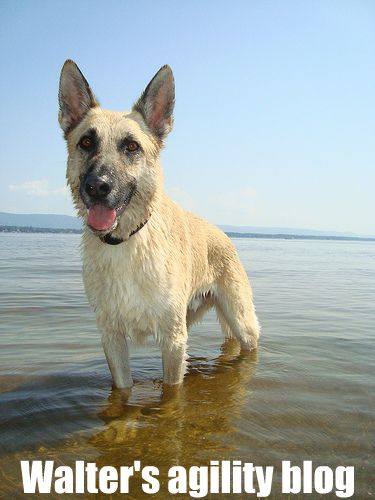Got in half an hour of practice before class. Focused on see-saw and weave-o-matics. I'm keeping him on-leash for the see-saw so I can keep him from speeding through the tilt point. A few times the tilt was fairly fast and loud, but he wasn't bothered since he was getting all kinds of treats. After a few practice runs, I raised the poles up higher than ever before, and he did very well. Took our first agility photos:

Posing in front of the dogwalk and a-frame

Outside the ring, taking a break in the shade between practice and class, watching his classmates arrive
The class warm-up was four stations, two or so minutes at each one: (1) jump to weaves; (2) tire, holding on to the dog and charging him up; (3) figure 8 (front cross) over two jumps; (4) see-saw with instructor assist. Next, we did a timed run on the a-frame, from hitting the frame to freezing in the contact. Walter did it in 2.6 seconds, tied with another dog for fastest in the class. Then, she added a jump before the a-frame. Walter scored 4.1 seconds, again tied for fastest. Surprising since Walter's normally not too fast. After that, we did the following sequence: jump, 90 degrees left to another jump, a-frame, front cross at contact, 90 degrees right to jump. Everyone did it twice. Walter did well enough, although his jumps are not very "poppy" and I need to work on getting him to work out farther from me so I don't have to babysit him quite as much. Finally, we learned a new move, the rear cross. The setup was a jump followed by the tunnel in a straight line. Call the dog, who's on your right side, over the jump, then with your LEFT hand guide them to the tunnel sort of curving your hand motion to the right; once they're in, move to the right side of the tunnel and see which way the dog looks when out of the tunnel. The idea is that with 3 of the 4 cues (voice, shoulders, and momentum) you're asking the dog to go straight, but with the fourth cue (hands) you're asking the dog to turn AFTER they do the next obstacle. Eventually (for some dogs quicker than others!) the dog should learn to turn to the appropriate side after the obstacle. Some dogs did this on their very first try, but not Walter, who turned left on both tries. Ah well, something else to work on!

No comments:
Post a Comment